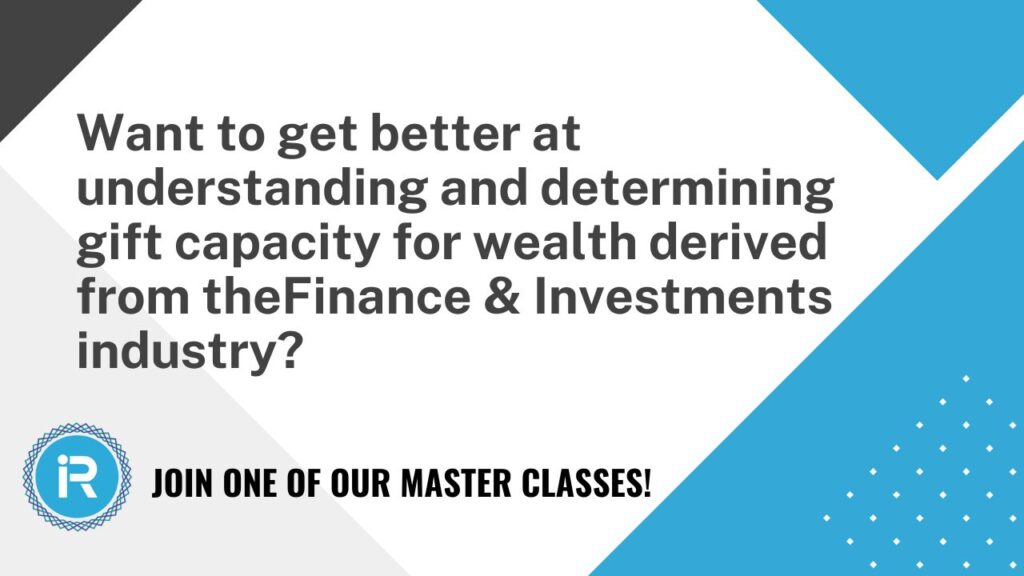Finance Industry Series Part 3 of 5
Did you read The Chronicle of Philanthropy’s coverage of the Top 50 Philanthropists this year? If you did, you would find that there are a lot of new names on the list – such as the retired clarinetist who was a closeted investor – to the tune of a $100 million gift!
Here is how you spot donors like this in your database right away:
- Close your eyes,
- Tap your red, sparkly heels together three times, and
- Say “I want a top donor. I want a top donor. I want a top donor.”
Okay, I’m not being serious and you are not Dorothy in the Wizard of Oz. Because we are talking about humans after all, and humans are complicated and messy.
That retired clarinetist had been giving increasingly larger gifts for years, but there was nothing that would have suggested he had such a vast treasure trove of private investments.
He had crossed the threshold into major gifts by establishing an endowment and the university did listen and respond when he said he wanted to do more, even though they had no idea more meant $100 million more.
Can research spot these undercover multi-million-dollar prospects? Really?
Maybe that’s not even a good question to ask.
No, research could not have uncovered the clarinetist donor. But we can uncover plenty of donors who do have public indicators of extraordinary wealth and tell our gift officers about it. And those same donors might be able to give a lot more than just money.
The Chronicle of Philanthropy just published a feature article on philanthropist Sean Fieler. You may or may not agree with Mr. Fieler’s conservative ideology, but the article was very instructive on how to spot a transformative donor in the wild – and young, too. He was in a hedge fund firm.
The Finance Industry churns out extraordinary wealth.
So why do so many prospect research professionals feel uncomfortable assigning high gift capacity ratings to individuals in the financial industry? Maybe…
- Because it’s often a guesstimate of net worth
- Because process and procedure cry for consistency and replication
- Because who needs manual research when the algorithm can assign a number
- Because it’s not easy to learn finance
The Prospect Research Institute is running the Finance 5 series of Master Classes this year: hedge funds, private equity, venture capital, investment advisor, and investment banking. Hedge funds lead the pack in minting global billionaires out of the Finance & Investments category. (Sure, there’s always Warren Buffet, but he’s an outlier.)
Mr. Fieler is a great example. He chose the world of hedge funds for his finance career. If my organization’s mission aligned with his philanthropic inclinations, I would definitely flag him as someone to connect with as early as possible. He not only gives money, but he is a dedicated and passionate board member. The Chronicle of Philanthropy article described a time when he provided transformative advice to the nonprofit he served.
You have wealthy prospects. Set aside your fear of gift capacity variations.
The Forbes Billionaire List is a small portion of the global elite. How do I know? At Aspire we research the billionaires that are NOT on this list.
Like the prospect who became president of an asset management firm in the 1980s – as a 30-something year old – and grows the firm successfully. He stays on – and benefits from – the firm being purchased a few times. About 15 years later he separates from the firm to establish a new firm. Nearly 18 years later his name is passed on to us at Aspire Research Group for profiling.
If we had simply stated name, title, and firm with an estimate of earnings, he would have been vastly underrated.
Instead, we found his percent of ownership in the SEC Form ADV and were able to calculate a sense of his current wealth – not super specific – as well as take into consideration the years of accumulated wealth from a fascinating story of business success. Was he philanthropic? Yes, that too.
Why would we refuse to recognize him as a billionaire (or really close) simply because he isn’t on the Forbes list? Have you read what it takes to be eligible for the Forbes list?
We researchers are not accountants. We don’t even have to have standards as tight as Forbes. Why? Because we need our gift officers to be confident and bold when asking for a gift from an interested and philanthropic billionaire.
Get educated or go home!
The financial industry is just one example of existing donors in your database that are hiding in plain sight. If you are afraid to tell your gift officers about the wealth of opportunity, and it’s because you don’t understand how to evaluate these donors, then I have a solution. Get educated.
Join me to learn about complex topics like hedge funds and private equity in a safe environment with opportunities to practice and ask questions.
Check out the Master Classes at the Prospect Research Institute today, and sign up for one that fits what you need to learn.
Additional Resources
- Top of the Wealth List: Finance and Investments? | Finance Industry Series: Part 1 of 5 | Jennifer Filla Blog | 2023
- Alternative Investments: Sophistication Required | Finance Industry Series: Part 2 of 5 | Jennifer Filla Blog | 2023
- The Simple Way to Spot Million-Dollar Donors In Your Database | Finance Industry Series: Part 3 of 5 | Jennifer Filla Blog | 2023
- Affinity First Or ‘Why Is My Prospect Not On The Forbes List?’ | Finance Industry Series: Part 4 of 5 | Jennifer Filla Blog | 2023
- Venture Capital, Private Equity, and Hedge Funds – Don’t hesitate to rate! | by Jen Filla | iWave Blog | 2023
Finance 5 Blog Series
- Top of the Wealth List: Finance and Investments? | Finance Industry Series: Part 1 of 5 | Jennifer Filla Blog | 2023
- Alternative Investments: Sophistication Required | Finance Industry Series: Part 2 of 5 | Jennifer Filla Blog | 2023
- The Simple Way to Spot Million-Dollar Donors In Your Database | Finance Industry Series: Part 3 of 5 | Jennifer Filla Blog | 2023
- Affinity First Or ‘Why Is My Prospect Not On The Forbes List?’ | Finance Industry Series: Part 4 of 5 | Jennifer Filla Blog | 2023
- Can you really turn words into bigger gifts? Yes! | Finance Industry Series: Part 5 of 5 | Jennifer Filla Blog | 2023


2 thoughts on “The Simple Way to Spot Million-Dollar Donors in Your Database”
Comments are closed.